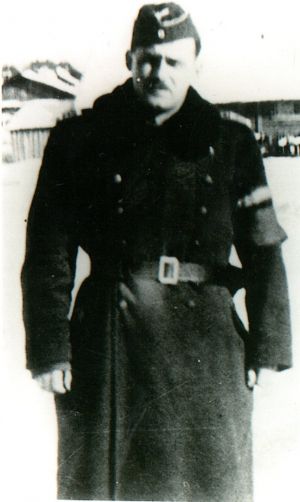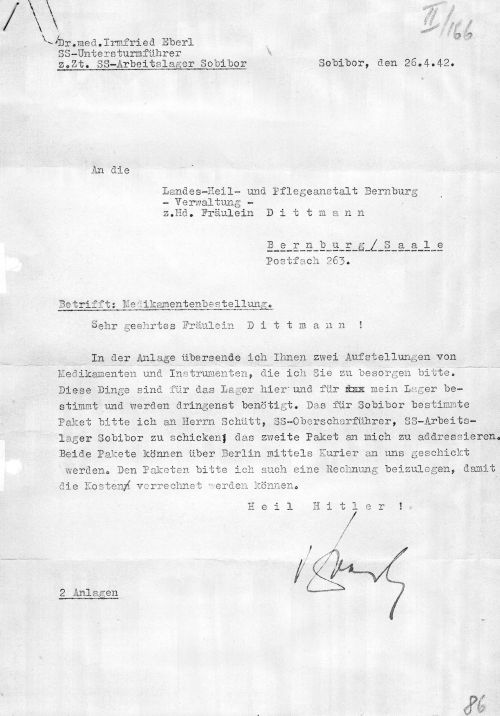Dr Irmfried Eberl

Dr Irmfried Eberl on the Eastern Front near Minsk
Commandant of Treblinka Death Camp June – August 1942
Irmfried Eberl was born on 8 September 1910, in Bregenz, Voralberg district, on the Bodensee (Lake Constance) in Lower Austria. He was the youngest of three brothers, the offspring of Josef Franz, an engineer and his wife Josefine. Eberl attended four years of elementary school and the Bregenz Gymnasium (Secondary School) where aged 17 he took his final exams on leaving school on 15 June 1928. He was the youngest in his class. At first he wanted to study law but later decided on medicine, and began his medical studies in 1929. On 8 December 1931, he joined the Nazi Party (Membership Number 687,095) and became the Nazi representative of the students union. At the same time, he also joined Motorsturm1 and SA-
In February 1935, aged 24, Eberl received his license to practice medicine and from 20 February until 27 May 1935, he was employed in the 2nd Medical Section of the Rudolf Foundation Hospital in Vienna and then from 28 May 1935 until 8 March 1936, at the Sanatorium for Lung Diseases in Grimmenstein, Lower Austria. After the assassination of Austrian Chancellor Dollfuss by the Nazis in 1934, the Nazi Party and all its organizations were banned in Austria, and Eberl’s illegal activities resulted in the withdrawal of his medical license in 1936. Now unemployed and without a future in Austria, Dr. Eberl crossed the border into Germany, as a political refugee Number 13,943.
For a month in April 1936, he was employed at the renowned Institute of German Hygiene in Dresden. The following month, he was the head of the Office for Social Welfare in Dessau, near Magdeburg. He subsequently served at the Main Health Office in Berlin. In January 1940, he was recruited by the Charitable Foundation for Institutional Care, the cover name of the organization that ran the Nazi euthanasia operation under the code designation ‘T4’. He was among the group of Nazi dignitaries and doctors who witnessed the first gassing experiment in mid-
From February 1940, Eberl was appointed to the post of the medical director of the ‘T4’ euthanasia institution in Brandenburg prison and when that institution ceased functioning at the end of 1940, he became medical director of the ‘T4’ institution established in a part of the mental asylum in Bernburg-

Dr Eberl letter written from Sobibor death camp - April 1942
Upon on his return to Germany in the spring of 1942, Dr. Eberl was sent briefly to the Sobibor death camp in eastern Poland, which was then under construction. Towards the end of June 1942, he was appointed the first Commandant of the Treblinka death camp, but within a little over a month, after the camp became operational -
Dr Eberl returned to the Bernburg institution for a short time, and according to the witness Fritz Bleich, who worked for ‘T4’ in a statement before the International Military Tribunal in Nuremburg stated that Dr. Eberl, along with other doctors Georg Renno and Horst Schumann went to Auschwitz concentration camp for about 6 months from October 1943, to carry out medical experiments on camp inmates. Dr Eberl was drafted into the German Army and at the beginning of April 1945, he was taken prisoner by American troops and interned in Luxemburg before being transferred to a Prisoner of War (POW) camp in Dietersheim on the River Rhine, close to the French border with Germany. After working in the TB department in the camp, he was released in July 1945. After the war had ended, he settled in Blaubeuren, near Ulm, in the Alb-
Sources
C.Webb & M. Chocholaty, The Treblinka Death Camp, Ibidem-
IMT Nuremberg – NO -
Document : Hessiches Hauptarchiv Wiesbaden, Germany
Photograph – Ghetto Fighters House, Israel
© Holocaust Historical Society 2018

